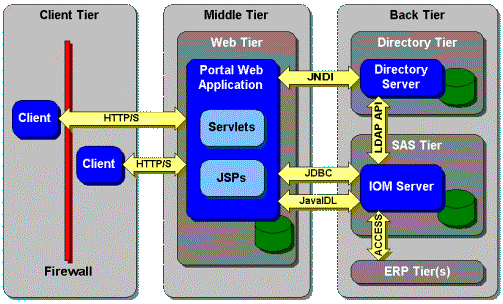



|
SAS Information Delivery Portal 1.1 |


|
As shown in the following figure, the SAS Information Delivery Portal is implemented using a multi-tiered architecture. This architecture has proven to be highly effective for developing and deploying enterprise applications.

The client tier consists of the components used to view the portal and its content. At a minimum, the client tier consists of a standard Web browser that is used to interact with the portal over standard Hypertext Transfer Protocol (HTTP) or HyperText Transmission Protocol, Secure (HTTPS). The use of these standard protocols makes the SAS Information Delivery Portal Web Application "firewall friendly." You can deploy the portal anywhere on your network and users can access it regardless of whether they are on your corporate intranet, extranet, or public Internet.
Depending on your content, the client may also use one or more standard desktop applications such as Adobe Acrobat Reader or Microsoft Excel. These applications are used to view content that is streamed by the servlets in the portal's middle tier. When the Web browser receives content that it does not know how to render, it looks at the mime-type of the content and tries to locate a viewer that knows how to display it. Standard Web browser functionality then redirects the stream to that viewer for displaying. Once the content is in one of these applications, the user can process it locally or save it to disk.
Another optional client application is the SAS Package Reader, which is part of the SAS Publishing Framework. The Package Reader enables you to view and manage the contents of a SAS package off-line, independent of the portal Web application. For more information, refer to the SAS Package Reader topic on the SAS Integration Technologies Web site.
The middle tier provides a centralized access point for enterprise information. All access to content is processed by components operating in this tier. This design point provides several advantages. The separation of the business logic from the display logic enables you to use different clients to leverage the logic on the middle tier. Another advantage is that the centralized point of access makes it easier to enforce security rules, administer the portal, and manage code changes.
The middle tier hosts the following functions:
The SAS Information Delivery Portal Web Application is the collection of Java servlets, JSPs, JavaBeans, and other classes and resources. These components work together to access information stored in the enterprise directory and present a customizable interface to the user.
The servlet container, also known as the servlet engine, is responsible for managing the SAS Information Delivery Portal Web Application. The servlet container provides a runtime environment that supports concurrency, life cycle management, deployment, and other services for the Java components.
The Web server provides services for the servlet engine. For example, the servlet engine relies on the Web server to provide HTTP message handling. The Web server can also be used to host Web sites that can be accessed through the portal.
The back tier is where the data servers and compute servers run. A compute server can also contain business objects. For example, a SAS IOM Server can contain SAS stored processes that analyze data and summarize results. As shown in the figure above, the SAS Information Delivery Portal Web Application uses standard interfaces like Java IDL and JDBC to communicate with and access data from IOM servers.
Another server in the back tier is the enterprise directory server. As described in Single Access Point to Enterprise Information, the enterprise directory server maintains metadata about content that is located throughout the enterprise. The directory does not contain the content, only metadata that describes it. This includes where the information is located, how to access it, and how it is related to other content items. The portal Web application uses the Java Naming and Directory Interface (JNDI) to access the enterprise directory server.
Note that the phrase "back tier" does not necessarily translate to additional hardware platforms. For small implementations, these servers can run on the same machine as the Web server. At the other end of the scale, a large enterprise may have multiple compute and data servers and an enterprise directory that is distributed across multiple platforms. The architecture of the SAS Information Delivery Portal gives you the flexibility to distribute these functions as required.

|
SAS Information Delivery Portal 1.1 |


|